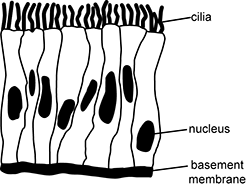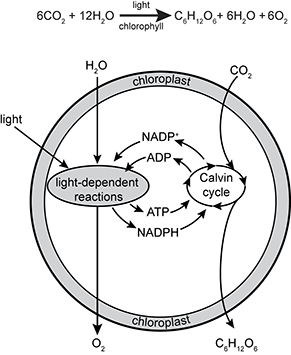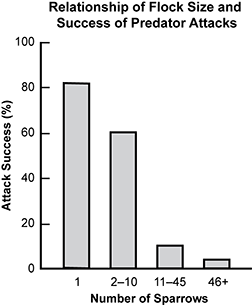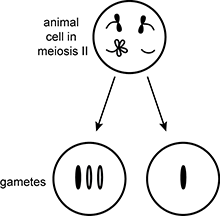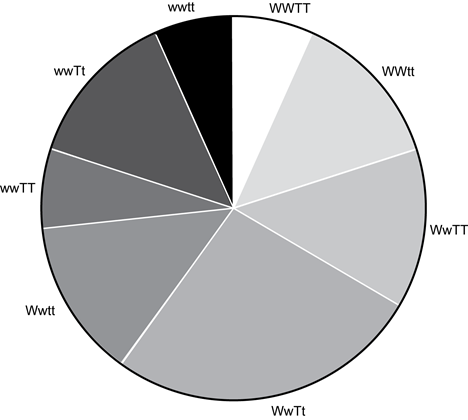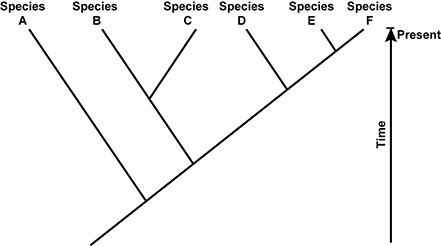Study Guide
Field 160: Biology
Recommendation for individuals using a screenreader: please set your punctuation settings to "most."
Sample Selected-Response Questions
Competency 0001
Structure and Function of Cells and Molecules
1. Use the diagram below to answer the question that follows.
A series of cells are shown, each of which contains a nucleus and stands up tall and thin from a basement membrane. All of the cells have cilia at the top.
The cell structure depicted in the diagram is most closely associated with the function of which type of tissue?
- trachea
- outer cheek
- ovum
- salivary glands
- Enter to expand or collapse answer. Answer expanded
- Correct Response: A. This item requires the candidate to demonstrate knowledge of the structure and function of different types of cells. The rectangular cell structures depicted here are called columnar cells and are most commonly epithelial cells. Tiny hair-like structures called cilia are present on the surface of the cells shown. Ciliated columnar cells line the human trachea, where the cilia play an important protective role by trapping and removing inhaled particulates.
Competency 0001
Structure and Function of Cells and Molecules
2. Bioengineers are working on the construction of artificial cell receptors that can be inserted into the plasma membrane of a cell. The application of this design is likely to be most effective in:
- enabling medicinal drugs to enter a targeted cell.
- preventing "nonself" substances from entering the cell.
- facilitating the passage of oxygen across the cell membrane.
- decreasing cellular responses to signal transduction activity.
- Enter to expand or collapse answer. Answer expanded
- Correct Response: A. This item requires the candidate to demonstrate knowledge of the engineering design process as related to the structure and function of cells and molecules, and the application of this process in real-world situations. Cell receptors can be used for many types of cellular communication, including initiating endocytosis, starting a signal cascade, promoting cellular development, and maintaining homeostasis. Receptors are able to initiate specific responses because they vary structurally so that, for the most part, one receptor binds to a specific site on the target cell. Different types of cells express different binding sites and receptor molecules, depending on their function within the body. Therefore, specific target cells can be pinpointed by putting specific artificial receptors on a lab-generated cell. If the membrane with the artificial cell receptors is also surrounding medicinal drugs, then it presents a way that drugs could be targeted to a certain cell type.
Competency 0002
Structure and Function of Organisms
3. In humans, a cut or scrape of the skin and damage to blood vessels causes the release of a chemical signal. This signal activates platelets, which in turn produce more of the signal. As a result, more platelets are activated and eventually a blood clot forms at the site of the injury. Which feedback loop described below helps maintain homeostasis in a similar way?
- Rising body temperature causes sweating and vasodilation, resulting in evaporative cooling and convective cooling and a reduction in body temperature.
- Contractions that occur during the process of childbirth increase pressure on the cervix, resulting in the release of oxytocin, which stimulates an increase in contractions.
- Antidiuretic hormone is secreted in order to retain water when dehydrated, increasing the amount of water in the blood and inhibiting the release of more of the hormone.
- High levels of glucose in the blood stimulate the release of insulin, resulting in the uptake of glucose by body cells, which lowers levels of blood glucose.
- Enter to expand or collapse answer. Answer expanded
- Correct Response: B. This item requires the candidate to analyze the feedback mechanisms that maintain homeostasis in humans. The process by which a blood clot forms at the site of an injury is an example of a positive feedback loop because the original stimulus of the activation of platelets is enhanced. In a similar way, during childbirth the release of oxytocin speeds up contractions. This, in turn, results in the release of more oxytocin. This positive feedback loop continues until the baby is born.
Competency 0002
Structure and Function of Organisms
4. One recent enhancement to medicine is computer-assisted, robotic surgery. This type of surgery is typically performed through several very small incisions. A tiny camera that magnifies and enhances the surgeon's field of vision is inserted into the patient. The image captured by the camera is displayed on a computer screen. Tiny instruments, which can bend and rotate far more than human hands, allow the surgeon to perform the surgery with greater precision and control. The surgery typically results in smaller incisions, decreased blood loss, less tissue trauma, less pain, and quicker healing time, when compared to traditional surgeries performed without computer-assisted robotics. Drawbacks of this technology include the approximate cost of 2 million dollars for a single robot and the approximate surgery costs of between 3 thousand dollars to 6 thousand dollars more than traditional surgery. In addition, the surgeon lacks the tactile sensation or the ability to "feel" the tissue being operated on. This may make the surgery more likely to intrude into surrounding organs.
Which real-world consideration may explain why a hospital would invest in this expensive type of computer-assisted, robotic surgery technology?
- Traditional surgery may be more likely to result in patient lawsuits.
- Robotic surgery may make a hospital more competitive with other hospitals.
- The high cost of the surgery may allow hospitals to increase profits.
- Robotic surgery may eliminate the need for a highly paid surgeon.
- Enter to expand or collapse answer. Answer expanded
- Correct Response: B. This item requires the candidate to demonstrate understanding of the engineering design process as related to real-world situations, taking into account a range of constraints, including cost, safety, reliability, and aesthetics, and considering social, cultural, and environmental impacts. Although more expensive than traditional surgery, computer-assisted, robotic surgery is more precise, less invasive, and leads to shorter hospital stays. Consequently, the use of robotic surgery as an alternative to traditional surgery provides the patient with a wider range of surgical options and may be viewed as a competitive advantage for the hospitals utilizing this technology.
Use the equation and diagram below to answer the two questions that follow.
An equation and a diagram are shown. The equation reads 6 C O subscript 2 plus twelve H subscript 2 O, together with light and chlorophyll yield C subscript 6 H subscript 12 O subscript 6 plus 6 H subscript 2 O plus 6 O subscript 2. In the diagram, a chloroplast is shown with light and H subscript 2 O entering light dependent reactions and O subscript 2 as a product of these reactions, along with A T P and N A D P H. A T P and N A D P H enter the Calvin cycle, along with C O subscript 2. C subscript 6 H subscript 12 O subscript 6 is a product of the Calvin cycle, along with N A D P superscript plus and A D P. N A D P superscript plus and A D P are shown entering the light dependent reactions.
Competency 0003
Matter and Energy
5. The equation and diagram shown provide information about the process of photosynthesis. The best summary of the difference between the equation and the diagram is that the diagram illustrates that:
- chloroplasts are located within the epidermis of a leaf.
- molecules involved in the production of sugar have a defined molecular structure.
- chloroplasts are the main location in which A T P can be used by a plant.
- molecules other than carbon dioxide and water are needed to produce a sugar.
- Enter to expand or collapse answer. Answer expanded
- Correct Response: D. This item requires the candidate to apply knowledge of the process of photosynthesis. Observable in the diagram is that the process of photosynthesis includes the generation of N A D P H and ATP , molecules which transfer electrons from the light-dependent reactions and are used to provide energy to drive the light-independent reactions of the Calvin cycle. Furthermore, once the high-energy phosphates and electrons from the carrier molecules are transferred, which makes sugar, the N A D superscript + and A D P return to the light-dependent reactions.
Competency 0003
Matter and Energy
6. Using the diagram shown, identify the statement that best supports the description of photosynthesis.
- Carbon dioxide is the only input to the Calvin cycle.
- Light-dependent reactions are the energy source for the production of glucose.
- Oxygen is produced through the utilization of N A D P H during the light-dependent reactions.
- Water drives the conversion of A D P to A T P .
- Enter to expand or collapse answer. Answer expanded
- Correct Response: B. This item requires the candidate to demonstrate knowledge of the significance of photosynthesis in the flow of energy and cycling of matter. As depicted in the diagram, the light-dependent reactions convert light energy to the chemical energy associated with the production of N A D P H and A T P . These molecules provide the energy needed for the synthesis of glucose in the Calvin cycle.
Competency 0004
Interdependent Relationships in Ecosystems
7. Which interaction between two species could be considered an example of commensalism?
- Hookworms attach to a dog's intestinal wall.
- Barnacles access external food by adhering to whales.
- Desert hawks and foxes both prey on snakes.
- Algae provide food and fungi grant protection in lichens.
- Enter to expand or collapse answer. Answer expanded
- Correct Response: B. This item requires the candidate to analyze dependencies between organisms in an ecosystem. In a commensal relationship, one organism benefits while the other is neither benefited nor harmed. Barnacles in the larval stage settle onto the skin of whales. As adults, these sessile crustaceans filter feed on plankton in the waters surrounding the whale. The whale is not affected by the presence of barnacles; thus, this is a commensal relationship.
Competency 0004
Interdependent Relationships in Ecosystems
8. Use the diagram below to answer the question that follows.
A bar graph is shown of the relationship of flock size and success of predator attacks. On the x axis is the number of sparrows and on the y axis is the percent of successful attacks. With a single sparrow, the percent of successful attacks is about 82%. With a flock of 2 to 10 sparrows, the percent of successful attacks is about 59%. With a flock of 11 to 45 sparrows, the percent of successful attacks is about 10%. With a flock of 46 or more sparrows, the percent of successful attacks is about 4%.
Based on the graph shown, it can be concluded that an increase in flock size increases:
- an individual bird's chance of survival against predators.
- the ability of individuals to defend themselves from a predator.
- an individual bird's visibility to predators due to increased noise and motion.
- the protection of sick or wounded individual flock members from a predator.
- Enter to expand or collapse answer. Answer expanded
- Correct Response: A. This item requires the candidate to analyze the influence of group behaviors on an individual's chances to survive and reproduce. As shown in the graph, as the size of a flock of sparrows increases from left to right on the x axis, the percent of successful attacks decreases. This means that if a sparrow is part of a larger flock, that individual is less likely to be attacked and therefore more likely to survive an encounter with a predator.
Competency 0005
Inheritance and Variation of Traits
9. Which statement best describes the primary role of t R N A in protein synthesis?
- It unzips genetic material to expose nucleic acids to enzymes.
- It holds genetic material, allowing for an amino acid chain to form.
- It transports genetic information from the nucleus to a ribosome.
- It recognizes genetic information, bringing with it amino acids.
- Enter to expand or collapse answer. Answer expanded
- Correct Response: D. This item requires the candidate to demonstrate knowledge of the structures and functions of R N A . A t R N A molecule has an anticodon triplet at one end that is specific to the amino acid carried by the molecule. During translation at the ribosome, the t R N A anticodon binds to a specific m R N A codon that pairs with the anticodon on the t R N A . With the help of the ribosome, it then adds the amino acid it carries to the growing polypeptide chain.
Competency 0005
Inheritance and Variation of Traits
10. Use the diagram below to answer the question that follows.
A diagram of an animal cell in meiosis two that is dividing into two gametes is shown. In the single animal cell, there are four curved lines connecting from dark and light shapes at the center of the cell and arching back to near the cell's edge. Two of the curved lines that are opposite one another each have a dark figure eight shape attached. One of the curved lines has two light figure eight shapes attached and the curved line opposite it has no figure eight shapes attached. The two gametes that result from the division of the animal cell are different from one another. Each gamete contains a dark oval but only the left gamete also contains both of the light ovals.
Which heritable change is shown in the diagram?
- nondisjunction
- crossing over
- inversion
- translocation
- Enter to expand or collapse answer. Answer expanded
- Correct Response: A. This item requires the candidate to analyze the processes that may produce heritable genetic variations. In the diagram of meiosis II shown, nondisjunction occurs because a pair of sister chromatids fails to separate. This results in the production of gametes that have an incorrect number of chromosomes.
Competency 0005
Inheritance and Variation of Traits
11. Directions: The distribution of flowers with genotypes for two particular genes growing in a field is represented by the chart shown below. The W and T genes undergo independent assortment. A certain bee pollinates a flower with the wwTt genotype. Click on the second parental flower genotype that the bee needs to pollinate in order for there to be a 50% chance that an offspring flower will have the Wwtt genotype.
A pie chart is shown divided into eight unequal pieces. Starting at the twelve o'clock position and moving clockwise is capital W W capital T T from twelve to one, then capital W W lowercase t t from one to two, then capital W lowercase W capital T T from two to four, then capital W lowercase w capital T lowercase T from four to seven, then capital W lowercase W lowercase T T from seven to nine, then lowercase W W capital T T from nine to ten, then lowercase W W capital T lowercase T from ten to eleven, then lowercase W W lowercase T T from eleven to twelve.
- Enter to expand or collapse answer. Answer expanded
-
Correct Response: The uppercase W W lowercase t t segment.
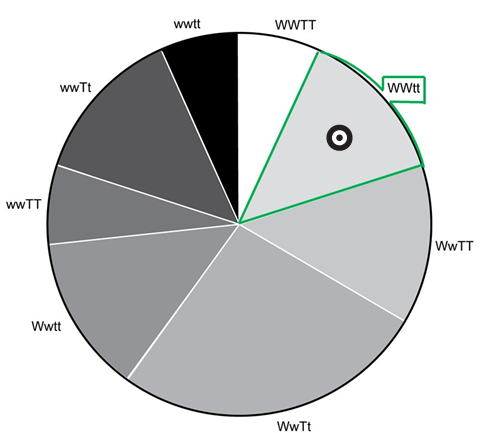
A pie chart from the question is shown again. The slice for uppercase W W lowercase t t is marked with a target, indicating it as the chosen and correct response.
This item requires the candidate to apply the laws of classical genetics. As genes W and T undergo independent assortment, all possible gene combinations would be illustrated as a dihybrid cross. Since Parent A is homozygous recessive for the W allele, the only gene combinations for Parent A are lowercase w uppercase T and lowercase w t . Because 50% of the offspring need a dominant allele for W to have a uppercase W lowercase w t t genotype, this eliminates any genotypes with two recessive genes for W ( lowercase ww ). As 50% of the offspring need to have two recessive alleles for T ( lowercase t t ) to have a uppercase W lowercase w t t genotype, this eliminates any genotypes with two dominant alleles for T ( uppercase T T ). That only leaves 3 possible genotypes for Parent B: uppercase W lowercase w t t , uppercase W lowercase w uppercase T lowercase t , or uppercase W W lowercase t t .
Genotype uppercase W lowercase w t t will result in two possible gene combinations— uppercase W lowercase T and lowercase w t —for Parent B, and the resultant cross has only 25% uppercase W lowercase w t t genotype, as shown in the Punnett square below.

A Punnett square is shown with two parents: parent A and parent B. Parent A is shown to have two possible gene combinations: lowercase W uppercase T and lowercase W lowercase T. Parent B is shown with two possible gene combinations: uppercase W lowercase T and lowercase W lowercase T. The possible offspring are first uppercase W lowercase W uppercase T lowercase T, next uppercase W lowercase W lowercase T T, third lowercase W W uppercase T lowercase T, and finally lowercase W W lowercase T T.
Genotype uppercase W lowercase w uppercase T lowercase t will result in four possible gene combinations— uppercase W uppercase T , uppercase W lowercase T , lowercase w uppercase T , and lowercase w t —for Parent B, and the resultant cross has only 12.5% uppercase W lowercase w t t genotype, as shown in the Punnett square below.
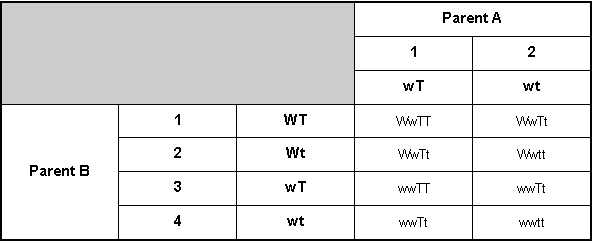
A Punnett square is shown with two parents: parent A and parent B. Parent A is shown to have two possible gene combinations: lowercase W uppercase T and lowercase W lowercase T. Parent B is shown with four possible gene combinations: uppercase W uppercase T, uppercase W lowercase T, lowercase W uppercase T, and lowercase W lowercase T. The possible offspring of the first gene combination for Parent A is first uppercase W lowercase W uppercase T T, then uppercase W lowercase W uppercase T lowercase T, third lowercase W W uppercase T T, and finally lowercase W W uppercase T lowercase T. The possible offspring of the second gene combination for Parent A is first uppercase W lowercase W uppercase T lowercase T, then uppercase W lowercase W lowercase T T, third lowercase W W uppercase T lowercase T, and finally lowercase W W lowercase T T.
Genotype uppercase W W lowercase t t will result in one possible gene combination— uppercase W lowercase T —for Parent B, and is the only genotype with a resultant cross of 50% uppercase W lowercase w t t genotype, as shown in the Punnett square below.

A Punnett square is shown with two parents: Parent A and Parent B. Parent A is shown to have two possible gene combinations: lowercase W uppercase T and lowercase W lowercase T. Parent B is shown with one possible gene combination: uppercase W lowercase T. The possible offspring are first uppercase W lowercase W uppercase T lowercase T and then uppercase W lowercase W lowercase T T.
Competency 0006
Evolution and the Unity and Diversity of Life
12. Use the information below to answer the question that follows.
Mitochondria contain the protein cytochrome c, which functions as an electron carrier during cellular respiration. The amino acid sequences of the cytochrome c proteins in many species have been identified and compared. The table displays the differences found between the cytochrome c amino acid sequences of humans (used as the standard) and several other species.
Number of Differences in the Amino Acid Sequences of Cytochrome c Organism Number of Differences horse 6 dog 8 pigeon 12 rattlesnake 14 snapping turtle 15 fruit fly 29
Which conclusion can be drawn from the data shown in the table?
- Snapping turtles evolved earlier than humans.
- Horses and dogs are more closely related to humans.
- Pigeons and rattlesnakes are in the same family as humans.
- Fruit flies evolved a less functional form of cytochrome c than humans.
- Enter to expand or collapse answer. Answer expanded
- Correct Response: B. This item requires the candidate to analyze evidence from molecular biology that explains common ancestry and biological evolution. Over time, once two species have undergone speciation, mutations in the DNA sequence specifying the cytochrome c protein occur. This changes the amino acid sequence. Closely related species will have fewer differences in their respective amino acid sequences because they underwent speciation relatively recently. An example of this is shown in the data table with the information provided for the horse and dog. These organisms, respectively, have 6 and 8 differences compared to the amino acid sequence for humans and thus are more closely related to humans than the other species listed.
Competency 0006
Evolution and the Unity and Diversity of Life
13. Use the diagram below to answer the question that follows.
A diagram is shown that is connecting species A through F on lines. There is a time arrow showing that all six species are in the present and their connections occur at some point back in time. Most of the species are connected by a main line that starts at an unlabeled point and then has branches off of it. Species A has the longest branch off of the main line, followed by species B as the next longest. Midway off of species's B line, species C branches off. Species D branches off the main line after species B but with a significantly shorter line. Species E and F branch off at the same time and have the shortest branch lengths.
Which statement is the most appropriate interpretation of the information presented in the phylogenetic tree?
- The most recent common ancestor of the species listed is unknown.
- Species A and B have the most mutations of the species listed.
- The species listed are representative of a single order.
- Species E and F are the most closely related species.
- Enter to expand or collapse answer. Answer expanded
- Correct Response: D. This item requires the candidate to interpret representations of evolutionarily related species. Relatedness of the species shown in the diagram, which is called a cladogram, is reflected by their placement in the cladogram and is based on common ancestry. The shorter the branches that connect two species, the more closely they are related and the more recently they share a common ancestor. In this case, species E and species F are closely related and evolved from a common ancestor most recently.

